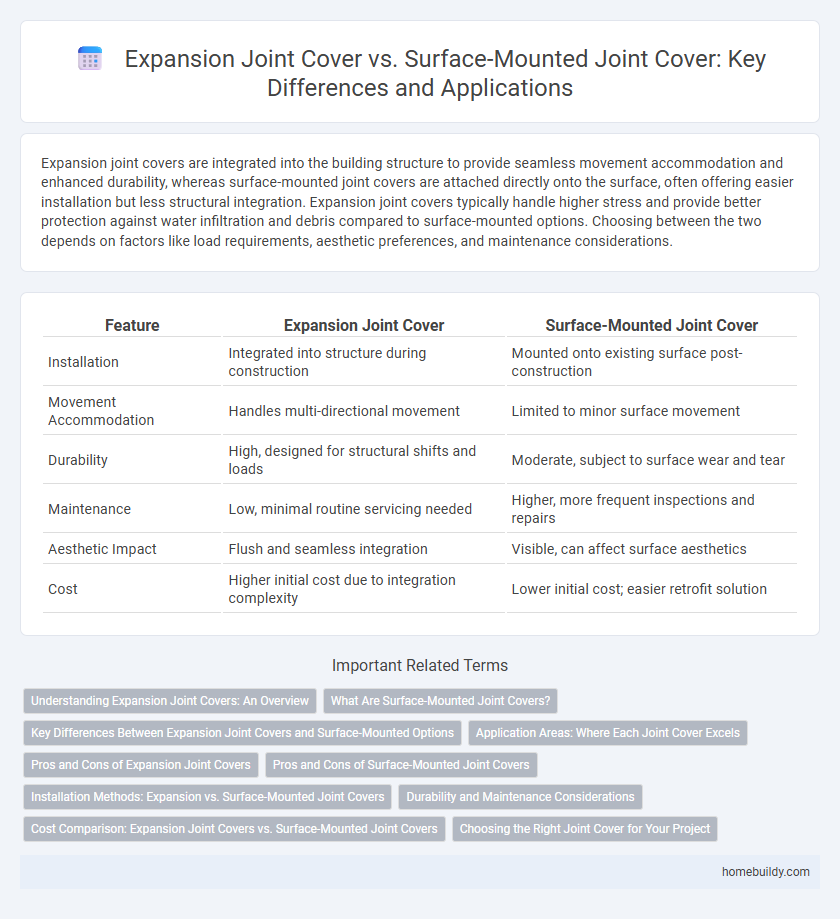Expansion joint covers are integrated into the building structure to provide seamless movement accommodation and enhanced durability, whereas surface-mounted joint covers are attached directly onto the surface, often offering easier installation but less structural integration. Expansion joint covers typically handle higher stress and provide better protection against water infiltration and debris compared to surface-mounted options. Choosing between the two depends on factors like load requirements, aesthetic preferences, and maintenance considerations.
Table of Comparison
| Feature | Expansion Joint Cover | Surface-Mounted Joint Cover |
|---|---|---|
| Installation | Integrated into structure during construction | Mounted onto existing surface post-construction |
| Movement Accommodation | Handles multi-directional movement | Limited to minor surface movement |
| Durability | High, designed for structural shifts and loads | Moderate, subject to surface wear and tear |
| Maintenance | Low, minimal routine servicing needed | Higher, more frequent inspections and repairs |
| Aesthetic Impact | Flush and seamless integration | Visible, can affect surface aesthetics |
| Cost | Higher initial cost due to integration complexity | Lower initial cost; easier retrofit solution |
Understanding Expansion Joint Covers: An Overview
Expansion joint covers are designed to accommodate building movement and prevent damage by bridging gaps between structural elements. Unlike surface-mounted joint covers, which are installed directly on the floor surface, expansion joint covers integrate seamlessly with the building structure, providing enhanced durability and flexibility. Key materials used include aluminum, stainless steel, and flexible rubber, ensuring effective load transfer and weather resistance in various construction applications.
What Are Surface-Mounted Joint Covers?
Surface-mounted joint covers are protective systems installed directly on the surface of expansion joints to accommodate building movement while maintaining a smooth finish. These covers are designed to handle moderate movement and provide a cost-effective solution that is simpler to install compared to embedded expansion joint covers. Typically made from durable materials like aluminum or stainless steel, surface-mounted joint covers enhance structural flexibility and prevent debris infiltration.
Key Differences Between Expansion Joint Covers and Surface-Mounted Options
Expansion joint covers are designed to accommodate structural movement by spanning the joint and allowing expansion and contraction without compromising the building envelope, whereas surface-mounted joint covers primarily provide a protective barrier on the surface with limited flexibility. Expansion joint covers integrate seamlessly within the structure to handle dynamic loads and compressive forces, while surface-mounted options are easier to install but often less effective in managing significant movement. Key differences include the level of movement accommodation, durability under stress, and the impact on architectural aesthetics.
Application Areas: Where Each Joint Cover Excels
Expansion joint covers are ideal for large-scale infrastructure projects such as bridges, highways, and commercial buildings where accommodating structural movements with minimal surface disruption is critical. Surface-mounted joint covers excel in interior applications like offices, hospitals, and retail spaces, offering easier installation and maintenance while managing thermal and seismic expansions. Both types ensure durability and safety, but the choice depends on the environmental demands and movement capacity required by the specific application area.
Pros and Cons of Expansion Joint Covers
Expansion joint covers provide superior flexibility and durability by accommodating building movement and preventing debris infiltration, making them ideal for high-traffic and seismic zones. They offer a flush, integrated appearance and better waterproofing compared to surface-mounted joint covers, but their installation involves higher costs and more complex engineering. Maintenance can also be more challenging, as these covers require periodic inspection to ensure the seal integrity and proper function over time.
Pros and Cons of Surface-Mounted Joint Covers
Surface-mounted joint covers offer easy installation and accessibility for maintenance, making them suitable for applications requiring frequent inspection or adjustment. However, they can be more prone to damage and wear due to their exposure on the surface, potentially affecting durability and aesthetic appeal. Their design may also cause tripping hazards or interfere with surface-level operations in high-traffic areas.
Installation Methods: Expansion vs. Surface-Mounted Joint Covers
Expansion joint covers are typically installed by integrating directly into the structure, allowing for natural movement and thermal expansion without compromising the building envelope. Surface-mounted joint covers are affixed to the substrate surface, providing easier installation but less flexibility for dynamic structural shifts. The embedded installation method of expansion joint covers ensures superior durability and performance in accommodating building movements compared to surface-mounted systems.
Durability and Maintenance Considerations
Expansion joint covers offer superior durability compared to surface-mounted joint covers due to their recessed installation, which reduces exposure to wear and environmental elements. Maintenance demands for expansion joint covers are typically lower, as their protected placement minimizes debris accumulation and damage risks. Surface-mounted joint covers may require more frequent inspections and repairs, especially in high-traffic or harsh conditions.
Cost Comparison: Expansion Joint Covers vs. Surface-Mounted Joint Covers
Expansion joint covers generally involve higher initial costs due to integrated design and durability features, while surface-mounted joint covers offer a more budget-friendly installation with easier maintenance. Long-term expenses for expansion joint covers may be offset by their superior performance in accommodating building movements and minimizing damage. Cost efficiency depends on project specifics such as building size, movement expectations, and maintenance capacity.
Choosing the Right Joint Cover for Your Project
Selecting the right joint cover is crucial for accommodating building movements and protecting structural integrity. Expansion joint covers provide flexible, durable solutions designed to absorb thermal shifts, seismic activity, and vibration, making them ideal for dynamic environments. Surface-mounted joint covers offer easier installation and maintenance but may lack the flexibility and longevity required for heavy traffic areas or large structural movements.
expansion joint cover vs surface-mounted joint cover Infographic

 homebuildy.com
homebuildy.com